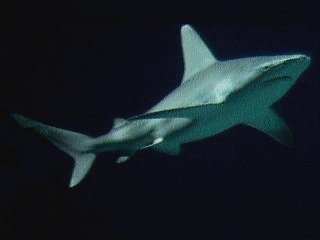 |
There are over 350 species of sharks.
They live all over the ocean, in cold to temperate waters, usually cooler
than 90 degrees Fahrenheit. Almost all sharks are carnivores, eating
dolphins, seals, sharks, and other fish. They are cold-blooded animals. This
means that their bodies change temperature as the water's temperature
changes. Sharks are built cruise slowly through the water for long
distances. A shark's skeleton is made of cartilage which is tough and
flexible, similar to a human's ear, and it has 5 to 7 pairs of gill slits.
These slits help the shark to absorb oxygen from the water into the
bloodstream. Its skin is like a spiky suit of armor. You can be injured by
simply touching the shark. These teeth like scales, or denticles, are shed
and replaced just as the teeth in their powerful jaws are. |
| Sharks have a lifetime supply of teeth.
An adult goes through 7 to 12 sets of teeth in a year. Different species of
sharks have different types of teeth in order to satisfy their needs. Sharks
do not use their teeth to chew. They swallow things whole or in big pieces.
A shark's design is excellent for hunting. They can hear, smell, and feel
everything in the water at great distances. Depending on its species, sharks
have from 1 to 100 babies at a time. While some sharks lay eggs, others give
birth to live babies. Many others do not care for their pups after they are
born, although they will search out safe places, called nurseries, where
they can lay eggs or give birth. After birth, many pups swim close to shore
to grow up on their own. A shark is usually not full grown until it is 10 to
15 years old, and some live to be a hundred. |
 |

